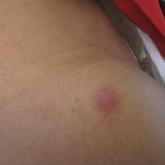Article

Erythematous and Necrotic Papules in an Immunosuppressed Woman
- Author:
- Kimberly Blain, MD
- Ashley Brown, MD
- Alde Carlo P. Gavino, MD
A 40-year-old woman with relapsed acute lymphoblastic leukemia complicated by prolonged pancytopenia presented with multiple tender, erythematous...
